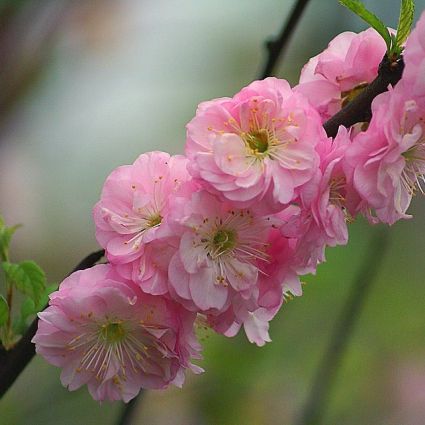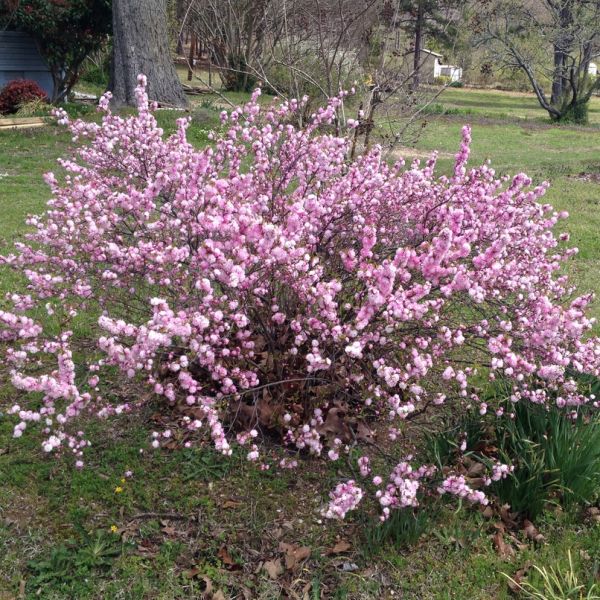

Pink Flowering Almond
Prunus glandulosa 'Rosea Plea'
85 reviews
Pink Flowering Almond
Prunus glandulosa 'Rosea Plea'
85 reviews
2.5 Gallon 1-2 Feet
We are sorry, product is currently out of stock due to seasonal availability. Please check the "Related plants available in your area" section below
Not just beautiful - intentionally selected by ShrubHub's 3D landscape design team to fit real-world spaces and maximize yard potential.
Why Pink Flowering Almond?
The Pink Flowering Almond, also known as Prunus glandulosa 'Rosea Plea', is a deciduous shrub that typically grows in a rounded shape up to six feet tall and wide. It is prized for its showy light pink, double flowers that bloom in early spring before the leaves emerge. This plant prefers full sun and well-draining soil, and can tolerate a range of temperatures, making it a popular choice for gardens and landscapes.
Sunlight
Pink Flowering Almond requires full sunlight, meaning it needs a minimum of 6 hours of direct sunlight per day to thrive and produce abundant blooms.
Watering
Pink Flowering Almond has a moderate watering requirement. It thrives in well-drained soil and should be watered deeply but infrequently. Avoid overwatering to prevent root rot. Regular watering during the growing season and occasional watering during the
Fertilizing
Pink Flowering Almond requires a balanced fertilizer with a ratio of nitrogen (N), phosphorus (P), and potassium (K) of 10-10-10. Apply the fertilizer in early spring before the blooming season for optimal growth and flowering.
Pink Flowering Almond: Embrace the Delicate Beauty of Nature's Blush
The Pink Flowering Almond is more than just a shrub; it is a poetic expression of nature's artistry. Its presence in your garden evokes a sense of serenity and rejuvenation, transporting you to a world where beauty reigns supreme. Its delicate blossoms sway in the gentle breeze, whispering tales of romance and enchantment. It serves as a reminder that even in life's simplest wonders, there lies a profound and undeniable beauty waiting to be discovered.
Scientifically known as Prunus triloba, the Pink Flowering Almond is truly a marvel of nature. Each spring, it bursts into a symphony of delicate pink blooms that blanket its branches, creating a captivating display that captures the hearts of all who behold it. Resembling exquisite rose petals, the flowers exude an irresistible charm and emit a gentle fragrance, beckoning you to come closer and revel in their exquisite beauty.
Beyond its stunning blossoms, the Pink Flowering Almond has the power to transform your garden into a romantic paradise. Picture yourself strolling along a path adorned with these magnificent blooms, as the soft pink petals delicately brush against your fingertips, immersing you in their ethereal allure. Whether as a focal point, lining a walkway, or adorning a flower bed, this graceful shrub adds an element of elegance and romance to any landscape.
What sets the Pink Flowering Almond apart is not only its captivating blooms but also its resilience and adaptability. Thriving in diverse climates and soil conditions, this hardy shrub stands tall, reaching heights of up to 6 feet. It is a perfect choice for gardens of any size, whether you seek a burst of color in a cozy courtyard or a graceful accent in a sprawling landscape. The Pink Flowering Almond never fails to leave a lasting impression.
Envision the Pink Flowering Almond gracing your garden with its delicate pink blooms, creating an atmosphere of serenity and warmth. Picture it as the centerpiece of a tranquil meditation garden, where its blossoms serve as a gentle reminder to pause, breathe, and appreciate the beauty that surrounds you.
Use it to craft a soft and romantic backdrop for outdoor gatherings, where friends and loved ones can revel in the splendor of nature's blush. With its timeless beauty, this captivating shrub effortlessly complements various garden styles, from classic to contemporary, infusing your space with grace and allure.
Plant Information:
| Botanical Name: | Prunus glandulosa 'Rosea Plea' |
| USDA Zones: | 4 - 8 |
| Water: | Medium |
| Exposure: | Full Sun |
| Soil Needs: | Well Drained |
| Mature Height: | 4 - 5 feet |
| Mature Spread: | 3 - 4 feet |






Pollination Info
Pink Flowering Almond (Prunus glandulosa 'Rosea Plea') is a self-fertile tree, meaning it does not require another tree for pollination. However, cross-pollination with another tree can increase fruit production and improve the quality of fruit.
Pollinators such as bees, butterflies, and other insects are attracted to the showy pink flowers of the Pink Flowering Almond tree. They transfer pollen from the stamen of one flower to the stigma of another flower, leading to fertilization and the development of fruit.
It is recommended to plant multiple Pink Flowering Almond trees in close proximity or to plant other fruit tree varieties nearby to improve cross-pollination and fruit production.
FAQ
Pink Flowering Almond (Prunus glandulosa 'Rosea Plea') FAQ
General Information
- What is the Pink Flowering Almond? Pink Flowering Almond (Prunus glandulosa 'Rosea Plea') is a small deciduous shrub that is known for its beautiful pink flowers that bloom in the early spring.
- How tall will the Pink Flowering Almond grow? It typically grows to be 6-10 feet tall and wide.
- What is the hardiness zone for the Pink Flowering Almond? The Pink Flowering Almond is hardy in zones 4-8.
Growing Conditions
- Where should I plant the Pink Flowering Almond? The Pink Flowering Almond prefers full sun to partial shade and well-draining soil.
- What is the best soil for the Pink Flowering Almond? The Pink Flowering Almond prefers slightly acidic to neutral soil with a pH between 6.0 and 7.5.
- How often should I water the Pink Flowering Almond? The Pink Flowering Almond prefers evenly moist soil but can tolerate some drought once established.
- How often should I fertilize the Pink Flowering Almond? The Pink Flowering Almond can benefit from a light application of a balanced fertilizer in the spring.
Maintenance
- Do I need to prune the Pink Flowering Almond? Pruning is not necessary, but removing old or dead branches can promote better flowering and a healthier plant.
- When should I prune the Pink Flowering Almond? Pruning should be done in the late winter or early spring before new growth appears.
- Does the Pink Flowering Almond have any pests or diseases? The Pink Flowering Almond can be susceptible to aphids, spider mites, and scale insects. It can also develop powdery mildew, leaf spot, and canker if grown in humid conditions.
Propagation
- How do I propagate the Pink Flowering Almond? The Pink Flowering Almond can be propagated by taking softwood or hardwood cuttings in the summer or fall and rooting them in well-draining soil.
- Is the Pink Flowering Almond self-fertile? No, the Pink Flowering Almond requires cross-pollination from another compatible cultivar to produce fruit.
Other
- Does the Pink Flowering Almond have any special uses? The Pink Flowering Almond is often used for ornamental purposes and is a popular choice for landscaping and garden design.
Planting & Care
Planting
- Choose a sunny location with well-draining soil
- Dig a hole twice the size of the root ball and loosen soil around the edges
- Place the root ball in the hole and level it with the surrounding soil
- Backfill with soil and water thoroughly
- Apply a layer of mulch around the base of the plant to retain moisture and discourage weeds
Care
- Water regularly, keeping soil moist but not waterlogged
- Apply a balanced fertilizer in early spring before new growth appears
- Prune in late winter or early spring to maintain shape and remove any dead or damaged wood
- Watch for pests such as aphids and treat with insecticidal soap if necessary
- Monitor for diseases such as powdery mildew and treat with fungicide if necessary
Check Out These Verified Customer Reviews:
Customer Reviews
4.7 out of 5 based on 85 reviews
Thank you! Your review has been submitted.
Overall, a great experience purchasing from this website and I would highly recommend to others.
Fast shipment, received the Pink Flowering Almond sooner than expected.
Easy online purchase
Item has been added to your cart.


